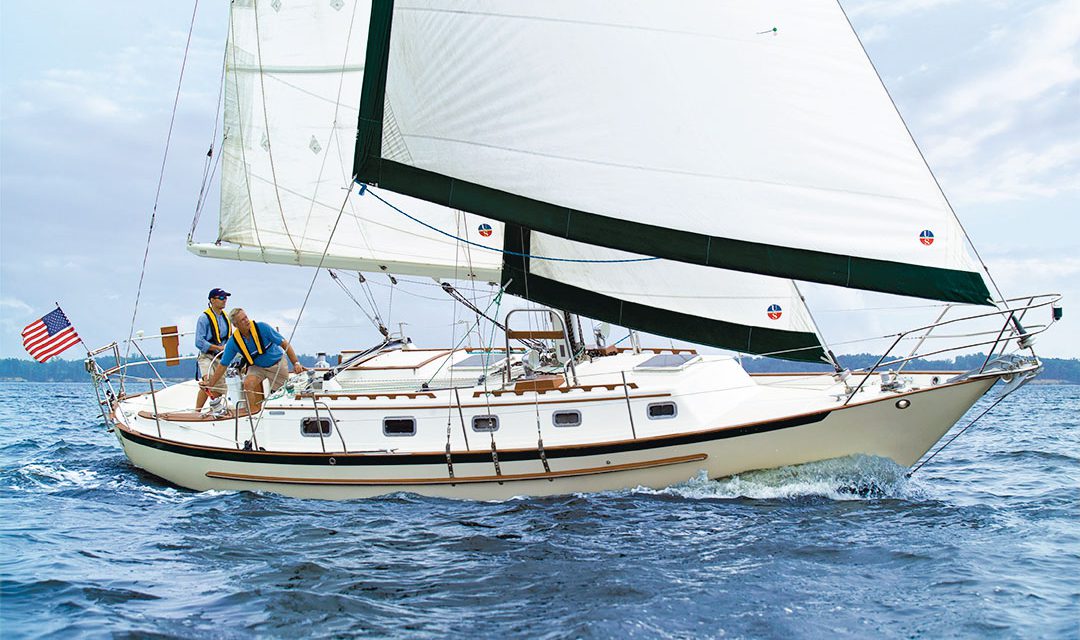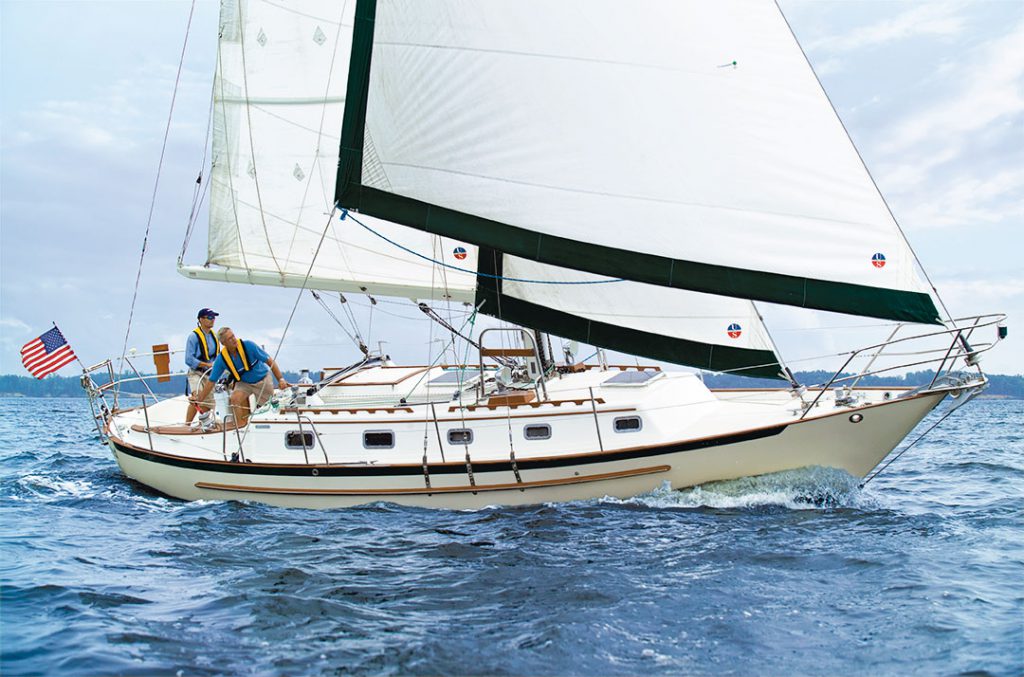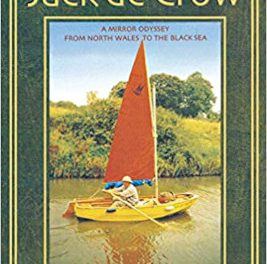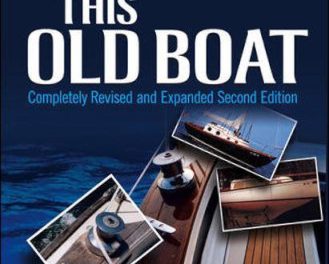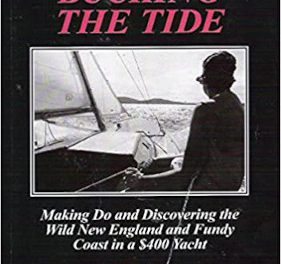An inspired, tough, seakindly cruiser
In the mid-1970s, naval architect William “Bill” Ion Belton Crealock entered a sailboat magazine’s boat design contest. Though already a successful designer, he said the contest was, “the only chance I’ve ever had to design a boat that didn’t have to please anyone else but me.”
The 37-footer Bill drew leaned on his bluewater experience gained cruising the Atlantic Ocean in a 40-foot gaff-rigged cutter in his 20s. Aesthetically sophisticated and classically proportioned, it featured modest overhangs, a classic sheer, low freeboard, and an elegant deckhouse.
He paid special attention beneath the waterline, drawing a hull with a large moderate aspect fin keel and a rudder hung on a skeg. Bill honed his boat’s entry for windward performance and gave her an attractive canoe stern that theoretically helps to part a following sea—what designer Robert Perry humorously calls the “Moses Effect.”
“The 37 is an attempt to provide the cruiser with a boat which will travel fast between ports under complete control, and which will yet remind him that the passage itself should be one of the pleasures of the cruise,” Bill said. He didn’t win the contest. “The boat that won was a very modern design for the time, actually a rather hideous boat, I thought. It quickly disappeared.”
History
At the time, Bill was working with a California company called Clipper Marine, which was producing a series of Crealock-designed trailer-sailers. The company began tooling for Bill’s new 37-foot keelboat, to be called the Crealock 37. Then Clipper Marine went belly-up without building a single hull. With hardly a pause, Cruising Consultants (CC) of Newport Beach, California, acquired the molds and between 1977 and 1979 produced 16 Crealock 37s. Then they went out of business.
Fortunately, Pacific Seacraft (PS), then in California also, in 1980 purchased the rights and molds. Working with Bill, Pacific Seacraft made some significant changes, and after about 15 years, in the mid-1990s changed the name from Crealock 37 to Pacific Seacraft 37, to be consistent with the names of other boats in their model line. To date, Pacific Seacraft has built several hundred examples.
In 2002, the boat Bill designed for himself was inducted into the American Sailboat Hall of Fame in Newport, Rhode Island, characterized as a boat that has “made boat ownership a love affair” for those lucky enough to sail one.
Martin Nelick and Sally Gardiner-Smith are among the lucky sailors. The couple own hull #7, a Cruising Consultants-built Crealock 37 named Shibumi. Sally and Martin are accomplished singlehanded sailors who have fairly aggressive sailing plans. After selling their respective singlehanding boats, they began searching for that “perfect” cruising boat. For them, their 1977 Crealock 37 is the one.
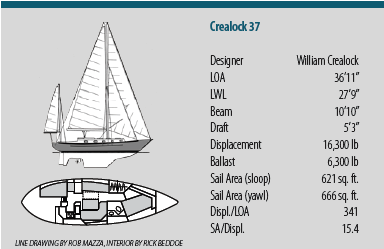
Design
Bill Crealock was born 100 years ago next month and grew up sailing in waters near his home in the United Kingdom. He was educated at Scotland’s Glasgow University, authored several books chronicling his sailing adventures, and produced designs for several successful boatbuilders including Cabo Rico, Westsail, Columbia, and Pacific Seacraft.
The Crealock 37 is traditional with an abundance of character. The cruising fin keel offers quick tacking and responsive handling in tight quarters, and coupled with the generous rudder skeg provides excellent directional stability compared to a narrower fin keel. This configuration also reduces the tendency of the rudder to stall at extreme angles of heel.
The boat has a moderately heavy displacement-to-waterline length ratio of 341, but because its LWL is relatively short for its overall length, the ratio, and boat speed, will increase as the boat heels and the waterline lengthens.
Rod Rowan of Crusader Yacht Sales in Annapolis, Maryland, which has been a Pacific Seacraft dealer since 1986, knows nearly all modifications made to the design through the several changes in ownership, including the company’s move from California to Washington, North Carolina, about a dozen years ago. He says that while the design drafts of the two keels offered were listed as 4 feet 5 inches and 5 feet 6 inches, actual measurements taken on delivered boats were closer to 4 feet 8 inches and 5 feet 10 inches as reflected in the current specifications. (Sailboatdata.com lists the boat’s draft at 5 feet 3 inches.) Rowan adds that the shoal-draft keel is a Scheel keel, designed and patented at one time by Henry Scheel with a shaped bulb at the bottom to improve lift.
Construction
While the Crealock 37 and Pacific Seacraft 37 are essentially the same design, they are not the same boat. Construction of both is conservative and strong, with hulls and decks of hand-laid fiberglass. The hulls are solid, and the decks were sandwich-cored with marine-grade plywood through the mid-1990s. Then builders switched core material to end-grain balsa with plywood inserts at deck hardware. Beginning in the late 1980s, Pacific Seacraft adopted vinylester resin, which is less hydroscopic than polyester, providing better protection against blisters.
The CC hull-to-deck joint incorporates a molded bulwark forming a flanged box that’s sealed with an elastomeric-type compound, through bolted, and then glassed over. Strong and dry, the resulting joint is finished with a 4-inch-wide teak cap rail. Rowan says most current boats are fastened with 1/4-inch x 20 stainless steel screws, 4 inches on center, plus 3M 5200 adhesive, with no leaks that he’s ever heard reported.
The differences in the two boats is most apparent in the interior. The CC interiors are stick-built, featuring teak-trimmed mahogany ceilings and an oak overhead. The sole is narrow oak planking with ebony polysulfide in the seams. Pacific Seacraft introduced molded fiberglass structural interior modules that retained most of the interior teak joinery while also brightening the spaces considerably. They use a longitudinal and transverse framing system, including mahogany-veneered plywood bulkheads tabbed with fiberglass to the hull and deck. For added stiffness, the main bulkheads are also attached via 5/16-inch through bolts using an ingenious teak beam system.
The keels of both CC and PS versions are solid-lead castings external to the hull and fastened with stainless steel bolts. Rowan says the original CC keel was scrapped in favor of the two current Scheel and standard keel options. The CC boats feature a Volvo saildrive unit forward of the skeg, whereas the PS boats have an aperture for the propeller.
Over the years, incremental changes were made to the PS boats, such as offering optional chrome-plated bronze portlights and hardware instead of bare bronze, and several different treatments for the inside walls of the coachroof—teak veneer and an off-white Formica. All interior teak was oiled until ’96 or ’97, after which a varnished option became available.
On Deck
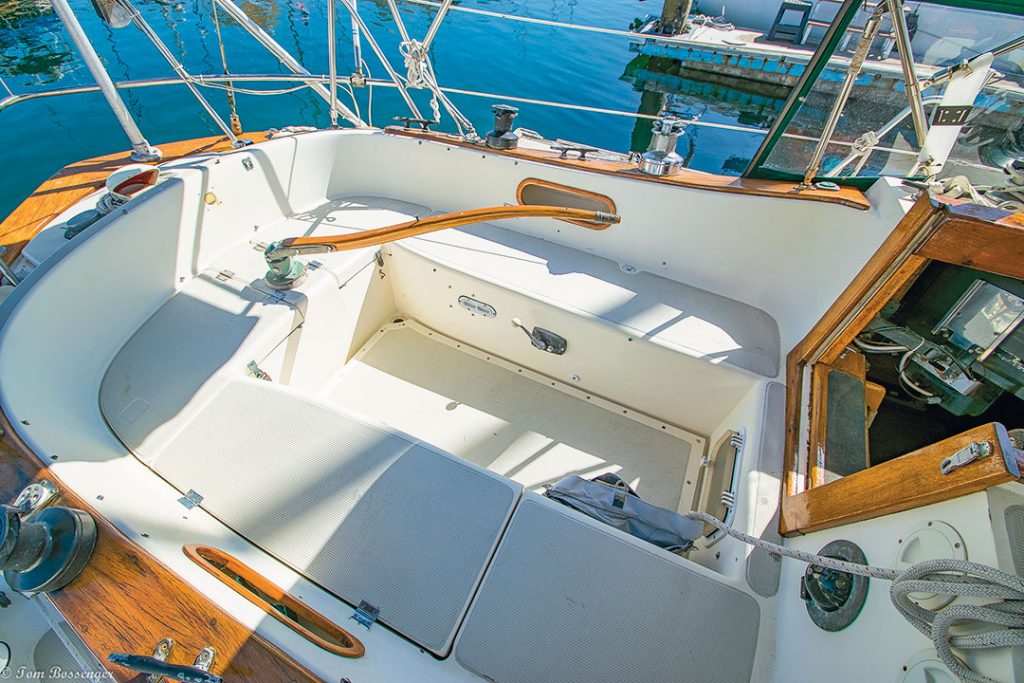
With only 16 Crealock 37s built, there’s scant information as to what was standard and what was optional. It also appears that a few of the final hulls were sold bare and owner-finished. Consequently, most of the CC Crealock 37 information in this review is based on what I found aboard Shibumi.
The cabintop is a bit cluttered. Notable features include a pair of 19 x 19-inch teak-trimmed bronze hatches, one over the V-berth and the other over the saloon. Four Dorade vents provide additional ventilation into the head, saloon, galley, and navigation station. Also on the cabintop, just forward of the sea hood and mainsheet traveler, are a pair of 39-inch-long tracks and cars to handle the staysail sheets.
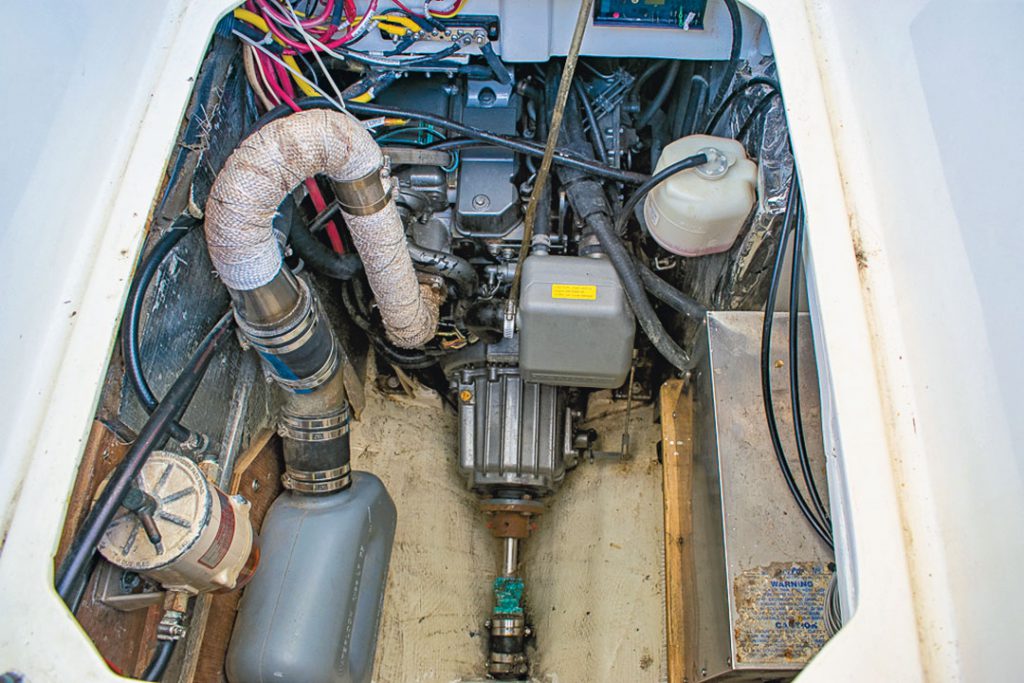
On the PS-built boats, engine access via the cockpit floor was modified and made smaller, about 2 x 2 feet.
Below Deck
The surprisingly roomy forward cabin is home to a V-berth that measures just over 7 feet 6 inches long at its head and narrows to 3 feet at its foot. On PS boats it’s offset to starboard. Besides an unusual overhead drawer, stowage for larger, bulkier items is available beneath the berth. Also beneath the V-berth is a 40-gallon aluminum potable water tank (an additional 60-gallon fiberglass tank is beneath the saloon sole).

Aft and to port of the V-berth is a hanging locker with bureau top. Three opening portlights and the overhead hatch provide this compartment with excellent illumination and ventilation.
Access to the head is directly across from the hanging locker. On Shibumi, the owners replaced the original marine toilet with an Air Head composting toilet in part to eliminate the need for a holding tank. In addition to hot-and-cold pressurized potable water, there’s also a saltwater hand pump. A solid mahogany door swings to close off the head as well as add privacy and a small changing area to the forward cabin.

The saloon is well ventilated with one opening portlight, two large fixed portlights, a single Dorade vent, and an overhead hatch. A pair of overhead grabrails makes for safe fore-and-aft maneuvering. Headroom is over 6 feet.
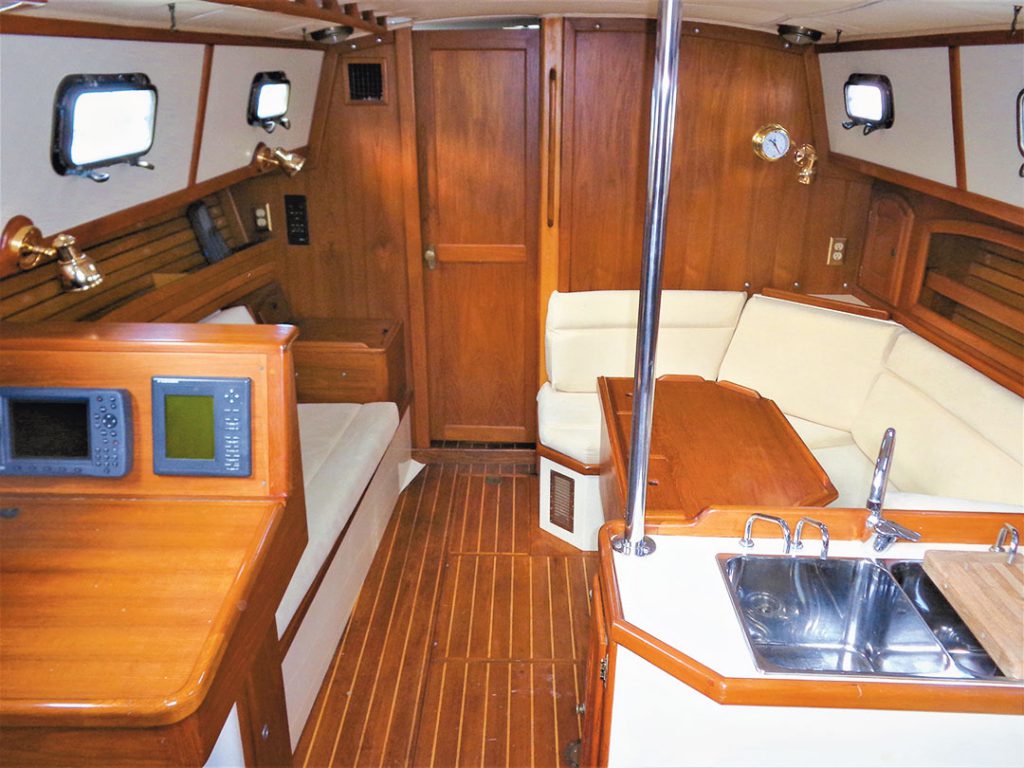
The L-shaped galley is immediately aft of the starboard settee. A series of drawers, a half-dozen cane-fronted lockers, and a clever dish stowage unit provide storage.
Rig
Shibumi is a yawl with double headsails. All spars are aluminum extrusions painted white with polyurethane. The mainmast and the mizzen are deck-stepped. Aluminum compression posts below support both; the mainmast post is incorporated into the main bulkhead, which in turn is glassed and bolted into place.
Mainmast rigging is a single set of spreaders, forestay, split backstay, a pair of cap shrouds, and double lower shrouds. Rigged with a staysail, Shibumi also has a pair of running backstays. The mizzenmast is supported by cap shrouds, intermediates, and lowers.
All standing rigging is stainless steel wire with bronze turnbuckles (stainless steel on PS boats). The stainless steel chainplates are outboard and bolted to the hull. When in port, the main boom rests on boom gallows. Both main and mizzen are sheeted mid-boom, the main to a traveler on the coachroof and the mizzen to a traveler mounted on the stern pulpit.
Headsail sheets lead aft through cars and tracks mounted on the caprails. These sheets terminate at Lewmar 27 self-tailing winches mounted on the cockpit coamings. Aft on the coachroof is a pair of Lewmar 10s to handle the staysail sheets and a #18 to service the mainsheet.
Initially, PS offered the 37 as a sloop, cutter, and yawl, though the latter was seldom ordered, and today most are sold as cutters and some sloops.
Underway
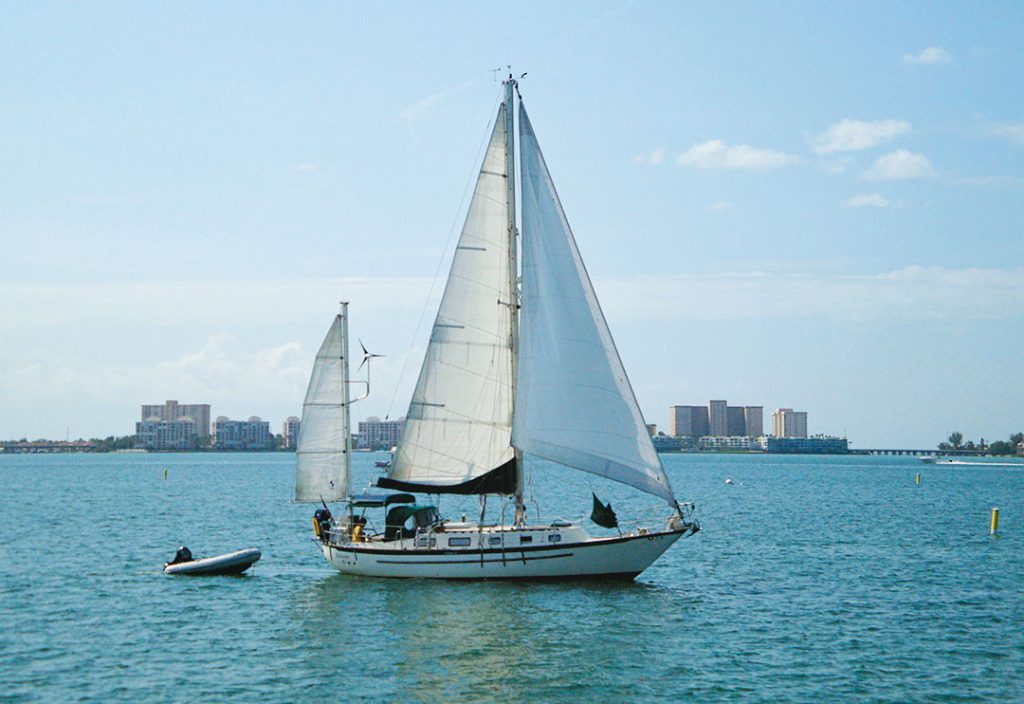
With a long sailing history and an excellent reputation for handling heavy weather, the Crealock 37 and Pacific Seacraft 37 are well balanced and easily managed by a short-handed crew.
With a bit of wind, the boat heels quickly to around 15 degrees. Once there, it’s rock solid. Rolling in the headsail a bit before tacking precludes it from hanging up on the staysail. With fairly quick acceleration and a responsive helm, the boat’s best point of sail appears to be a broad or beam reach.
While the boat is a bit narrow and heels early (less form stability, excellent ultimate stability), its seakindly nature makes long passages comfortable. The split rig adds versatility and easily adapts to self-steering. Under the right conditions and properly trimmed, the boat can eat up the miles. Over the years in the Singlehanded Transpac Race, two Crealock 37s, Coaster and Intrepid, have recorded corrected times that put them among the fastest 10 percent of all finishers.
Conclusions
This design is a Hall of Fame beauty. The boat is strongly built, well rigged, and has a documented reputation for sailing comfortably and fast. It has an abundance of stowage and is a good choice for a small crew. While a new 2020 Pacific Seacraft 37 will cost nearly $500,000, many clean examples from the 1980s and 1990s are available in a range of five-digit asking prices.
Gregg Nestor is a contributing editor with Good Old Boat. He has authored four books on sailing: Twenty Affordable Sailboats to Take You Anywhere, Twenty Comfortable Sailboats to Take You Cruising, The Trailer Sailer Owner’s Manual, and All Hands on Deck. He became a snowbird a few years back, after relocating his boat from the Great Lakes to Florida.
Comments from an owner of the CC-built Crealock 37
The Cruising Consultants version has larger windows, more light, and a nice, wide V-berth. Also, the yawl rig and external chainplates give it a swashbuckling appeal. The entire cockpit sole comes out for great engine access. Our 1978 Crealock 37 was converted from saildrive to direct drive, a plus I think. There is plenty of room in the cockpit as the tiller folds up; and, as there is no sub-cockpit steering binnacle apparatus, space remains below for water heater and watermaker. The lead keel is a major plus. It has a battle-ax stainless steel double bow roller.
Panels rather than vinyl in the ceiling make it easy to run wire and add LED lighting—a major improvement. A large propane locker fits three 5-gallon tanks. The deck glass is thick so it does not perceptibly flex even when coring was removed during repair. No major leaks.
It ghosts along in a light breeze but performs in 12-22 knots. With a 12- to 14-knot breeze on the beam I have put the tiller down and it tracks on its own. The mizzen staysail is a fun and easy sail that really does move the boat under the right conditions. When it gets to 28-30, I can put up just a working jib on the Solent stay and mizzen, and it moves along nicely under control.
The Dorade vent holes were not sealed—so I had to dig out soaked balsa, dry, and repair. The aluminum backing plates for the pulpit bars were corroding and compressing, so I replaced with G10. Original backing plates for the traveler were pieces of thick leather—replaced with G10. The gooseneck was secured to mast by one 3/8-inch bolt that had worked and loosened and been re-tapped repeatedly over the years. The fixed table takes up too much space, so I will be building a fold-away.
—Tim Lamarre, San Francisco, California
Comments from owners of the Pacific Seacraft-built Crealock 37
This 1989 boat sails nicely in light winds, but as I have aged I find myself motor sailing if I can’t get at least 4 knots of speed on wind alone. This is a relatively narrow boat so sails can really be pulled in and sailed close to the wind. You are almost always going to have a heeling motion, and it sails best that way. It sails confidently in rougher weather, is easily reefed, and handles waves better than most boats. Some say it hobbyhorses more than other cruisers, but I don’t think it does. With its canoe stern you can sure tell the difference sailing with the wind behind you; it is so easy to control, and the waves don’t grab the stern and push it around so much.
—Tom Eisele, Hilton Head Island, South Carolina
After a 2019 passage aboard a 1993 model from Bodega Bay, California, to Brisbane, Australia, I can comment about these things: With a crew of two or singlehanding, she is in her groove at 12-25 knots wind speed. Above 25 knots, when singlehanding, I have wished that I had a third reef available for the mainsail. During the harshest of weather systems, while using the trysail as the main and the staysail as the storm jib, the 37 sailed rock solid and on course through the tossed seas, allowing me to get rest below.
—Mark Tolbert, Redwood Valley, California

